| Published
on 11
May
2006 |
All rights reserved.
|
|
|
Racing Pedigree
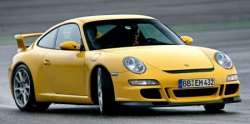 The
history of 911 GT3 can be traced back to the 2.7 RS of 1973. The
lightweight and sport-tuned version of 911won Porsche a lot of glory on
race tracks and gave the keenest drivers the highest driving
satisfaction on roads. Among all the road-going 911s, the Renn Sport
delivered the closest experience to racing car, one that demanded
superior driving skill but also rewarded good drivers with incomparable
feedback. Naturally, it became the most admired 911 in history. The
history of 911 GT3 can be traced back to the 2.7 RS of 1973. The
lightweight and sport-tuned version of 911won Porsche a lot of glory on
race tracks and gave the keenest drivers the highest driving
satisfaction on roads. Among all the road-going 911s, the Renn Sport
delivered the closest experience to racing car, one that demanded
superior driving skill but also rewarded good drivers with incomparable
feedback. Naturally, it became the most admired 911 in history.
After the mighty 2.7 RS, we had 3.0 RS (1974), 964 RS (1992), 964 RS
3.8 (1993) and 996 RS (1995) to follow this racing pedigree. In 1999,
the Renn Sport label gave way to GT3 - now RS became a striped out
version of GT3. The new car was so named because Porsche would race it
in FIA's newly established GT3 category. The first GT3 stunned the
world with its speed and handling. It employed a 3.6-litre boxer engine
developed directly from the GT1 race car instead of the road-going 911.
Lightweight pistons and titanium connecting rods resulted in amazing
rev and punch, while lightweight body resulted in a power-to-weight
ratio even higher than contemporary 911 Turbo ! its sport-tuned
suspensions delivered the sharpest handling. GT3 won the heart of
hardcore Porsche drivers as well as the top spot in AutoZine’s rating
page.
In 2003, Porsche updated the GT3 to the second generation – let me call
it “Series 2” because it was still based on the 996 architecture. This
time the changes were subtle – stiffer suspensions, higher rev and
slightly more power from the same engine. It remained the most
effective driver’s car in the world, but obviously the next generation
will need to take a bigger step.
997 GT3
So, this is what we are waiting for – the 997 GT3. In UK, it is priced
at £80,000, sandwiching between the £66,000 Carrera S and
the £93,000 new Turbo. Once you have read through this report,
you will see it is a great bargain.
Once again, the GT3 targets at the most demanding hardcore drivers,
even more so than the Carrera S and Turbo. Although the new Turbo might
be a little quicker in straight line, the lighter rear-drive GT3 is
supposed to be quicker on track for skillful drivers. For those who
participate club racing, Porsche also offers a Clubsport version
including a roll cage, carbon-fiber bucket seats, racing harnesses and
fire extinguisher.
 At the
first glance, you could be both excited and disappointed by the new
design. Excited
because it got some really serious aerodynamic kits, such as the deep
air dam, 5 aggressive intakes at the front bumper, four hot air outlets
at the rear bumper, a double-plane rear spoiler and a unique
centrally-mounted exhaust pipe. All these sounds like a track car. On
the negative side, these function-oriented tweaks hurt the coherent
shape characterizing all 911s and make it more like the work of tuners.
Personally, I still prefer the original 1999 GT3, whose design hit the
right balance between pureness and sportiness. At the
first glance, you could be both excited and disappointed by the new
design. Excited
because it got some really serious aerodynamic kits, such as the deep
air dam, 5 aggressive intakes at the front bumper, four hot air outlets
at the rear bumper, a double-plane rear spoiler and a unique
centrally-mounted exhaust pipe. All these sounds like a track car. On
the negative side, these function-oriented tweaks hurt the coherent
shape characterizing all 911s and make it more like the work of tuners.
Personally, I still prefer the original 1999 GT3, whose design hit the
right balance between pureness and sportiness.
Open the doors, the cockpit must be familiar to all 997 owners, even
most luxury equipments have been retained, so this is no longer a
striped-out machine like the old RS. The only weight saving measure is
the part-leather part-Alcantara lightweight bucket seats. Oh yes, your
dog may be disappointed to find out the rear seats have been discarded
to save weight. Obviously, the GT3 is not a car to take your dog
outside for a walk.
Chassis and Aerodynamics
 Now we
go to the technical side. From the specifications you will find the new
GT3 is wider than the old car by 38mm. Compare with the current Carrera
S, it has the same width but ride height is lowered by 20mm. This mean
its handling is inherently more stable than either cars. As before, the
GT3 is built on the Carrera 4 monocoque chassis to take advantage of
its stiffer front end structure and the possibility of fitting a bigger
fuel tank for racing purpose, but it is still rear-drive only. What
made difference is the upgrade from 996 to 997 chassis, which brings 8
percent higher torsional rigidity and 40 percent higher bending
stiffness. To offset the extra reinforcement are aluminum bonnet and
doors (like the new Turbo). Overall, the GT3 weighs only 15 kg more
than the old car, or actually the same as a base Carrera. Now we
go to the technical side. From the specifications you will find the new
GT3 is wider than the old car by 38mm. Compare with the current Carrera
S, it has the same width but ride height is lowered by 20mm. This mean
its handling is inherently more stable than either cars. As before, the
GT3 is built on the Carrera 4 monocoque chassis to take advantage of
its stiffer front end structure and the possibility of fitting a bigger
fuel tank for racing purpose, but it is still rear-drive only. What
made difference is the upgrade from 996 to 997 chassis, which brings 8
percent higher torsional rigidity and 40 percent higher bending
stiffness. To offset the extra reinforcement are aluminum bonnet and
doors (like the new Turbo). Overall, the GT3 weighs only 15 kg more
than the old car, or actually the same as a base Carrera.
Aerodynamics is another area of improvement. To compensate the larger
frontal area due to the extra width, The engineers at Weissach fine
sculpted the double-plane rear spoiler and used smooth underfloor
panels to reduce drag. As a result, drag coefficient is reduced from
0.30 to 0.29, which is probably the best figure a sports car can
achieve. Interestingly, the GT3 does not seem to be a model of modern
aerodynamics, as it does not have any diffusers (the rear engine won’t
allow that) thus need to seek help from old-fashion rear spoiler.
However, the low drag and the high-speed stability displayed from its
driving let us rethink whether rear spoiler is really a thing of the
past. GT3 proves that, if properly engineered, rear spoiler could lift
the styling as well as aerodynamic efficiency. Take note, Ferrari.
Engine and Performance
Last year, Carrera S introduced a 3.8-litre version of the boxer
engine. Naturally, we expected the new GT3 engine to enlarge to 3.8
litres as well. After all, more capacity and more power is the current
trend of engine development.
However, the GT3 engine is a development of the 1998 GT1 racer, hence
having no relationship at all with the rest of the 911 family. Unlike
other 911 engines, it employs very large bore (100mm) and short stroke
(76.4mm), versus the Carrera’s 96.0mm x 82.8mm and Carrera S’ 99.0mm x
82.8mm. In addition to lightweight pistons and titanium connecting
rods, one can easily see its racing genes. Unfortunately, Porsche
stopped developing the racing engine long ago. To increase its capacity
beyond 3600cc will require a thorough redesign and substantial
investment, which is considered to be too expensive for the low volume
GT3. That’s why Porsche decided to retain its capacity and rework the
components to find extra efficiency.
So what changes did it make? At the intake side, it increased the
diameter of throttle butterfly from 76mm to 82mm. It also added a new
resonance type variable intake manifold (previously called Varioram) to
optimize torque across a wider band. At the exhaust side, it employs
larger volume silencers to reduce back pressure. At the valvetrain, it
increased the valve lift by 0.4mm and extended the variation range of
the Variocam system from 45˚ to 52˚. In the combustion chambers, the
compression ratio is lifted from 11.7 to 12.0:1. In the reciprocating
parts, the conn-rods are lengthened to reduce thrust angle, hence
wasting less energy. The pistons become shorter and lighter. All these
put together, the new GT3 engine becomes even more revvy and powerful
than ever. It produces 415 horsepower at 7600 rpm, which translate to
an astonishing 115 horsepower per litre, even higher than Ferrari F430
(114 hp per litre) !! maximum torque now increases to 299 lbft at 5500
rpm. Max rev is lifted to 8400 rpm, almost like a touring race car.
To let you see the progress of the GT3 more easily, I made a comparison
table here:
|
996 GT3
|
996 GT3 (Series 2)
|
997 GT3
|
Year
|
1999
|
2003
|
2006
|
| Engine capacity |
3600 cc |
3600 cc |
3600 cc |
| Compression ratio |
11.7:1 |
11.7:1 |
12.0:1 |
Variocam range
|
25˚ |
45˚ |
52˚ |
Maximum rev
|
7800 rpm
|
8200 rpm
|
8400 rpm
|
Max power
|
360 hp / 7200 rpm
|
381 hp / 7400 rpm
|
415 hp / 7600 rpm
|
Max torque
|
273 lbft / 5000 rpm
|
284 lbft / 5000 rpm
|
299 lbft / 5500 rpm
|
Kerb weight
|
1350 kg
|
1380 kg
|
1395 kg
|
Drag coefficient
|
0.30
|
0.30
|
0.29
|
Top speed
|
188 mph
|
190 mph
|
193 mph
|
0-62 mph (0-100 km/h)
|
4.8 sec
|
4.5 sec
|
4.3 sec
|
0-100 mph (0-160 km/h)
|
10.2 sec
|
9.4 sec
|
8.7 sec
|
Nurburgring lap time
|
7 min 56 sec
|
7 min 54 sec
|
7 min 42 sec
|
As seen in the table, the new GT3 can top 193mph and accelerate from
0-100mph in only 8.7 seconds. That put it very close to Ferrari F430
(196mph, 8.1sec) and earn it a place in the world’s supercar club. More
brilliantly, such performance is achieved by a naturally aspirated
engine displacing only 3.6 litres. One word describes this car best:
Efficiency.
Suspensions and Brakes
 Like
other 997s, the new GT3 has added PASM (Porsche Active Suspension
Management) with adaptive dampers. Normal mode and Sport mode allow
different stiffness to suit road or track use. The 19-inch lightweight
wheels are shod with semi-racing Michelin Pilot Sport Cup tires which
can deliver up to 1.4g cornering force ! in case they run out of
traction, the limited slip differential will intervene. If that is
still not enough, the new traction control will ease off engine
power to regain traction. Of course, for a driver’s car like this you
can switch off the TC completely. Like
other 997s, the new GT3 has added PASM (Porsche Active Suspension
Management) with adaptive dampers. Normal mode and Sport mode allow
different stiffness to suit road or track use. The 19-inch lightweight
wheels are shod with semi-racing Michelin Pilot Sport Cup tires which
can deliver up to 1.4g cornering force ! in case they run out of
traction, the limited slip differential will intervene. If that is
still not enough, the new traction control will ease off engine
power to regain traction. Of course, for a driver’s car like this you
can switch off the TC completely.
Like the new 911 Turbo, the GT3 is offered with 350mm diameter
ventilated disc brakes with 6-pot front and 4-pot rear calipers.
Considering the GT3 is almost 200 kg lighter than the 4-wheel-drive
Turbo, its braking performance must be sensational. However, most
drivers are likely to pay for the optional 380mm PCCB ceramic brakes,
as they are simply fade-free on race tracks.
On the Road
The GT3’s boxer engine is gem. Initially it feels no different from a
regular 911 engine, delivering the same tractable manner and lovely
911-style exhaust note. Prod the throttle and you immediately feel the
difference: like a race motor, its rev goes up and down quickly, thanks
to the lightweight internals. As rev rise, the turbine-smooth
willingness transforms to enthusiastic eagerness – the boxer encourages
you to go harder and harder until the 8400rpm limit is exploited. There
is no tremendous g-force like a supercharged V8, but the superb
willingness and linearity of the GT3 engine delivers even more driving
satisfaction to keen drivers.
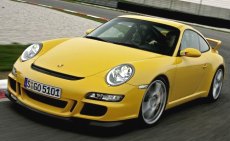 Achieving
top speed at Autobahn is easy, as the GT3 displays remarkable
aerodynamic stability at high speed. This is a noticeable improvement
from its predecessor. The damping also promotes high-speed stability.
At low speed, the damping at the normal setting of PASM is slightly
more comfortable than the last GT3. That said, on rougher surfaces the
ride quality is barely acceptable. The sport mode is even more crashy,
thus it is better to be left on race tracks. Achieving
top speed at Autobahn is easy, as the GT3 displays remarkable
aerodynamic stability at high speed. This is a noticeable improvement
from its predecessor. The damping also promotes high-speed stability.
At low speed, the damping at the normal setting of PASM is slightly
more comfortable than the last GT3. That said, on rougher surfaces the
ride quality is barely acceptable. The sport mode is even more crashy,
thus it is better to be left on race tracks.
However, the stiff suspension setup results in superb body control and
highly precise steering. The handling is close to race car level –
sharp and communicative. The grip generated by the Michelin Pilot Sport
Cup tires is simply astonishing, so is the tremendous traction coming
from the wide rear tires and the 62% weight acted on the rear axle. In
the GT3, we don’t talk of understeer or cornering limit, because you
need a race track to detect them.
Thanks to the superb engine, gearbox, steering and handling, the GT3 is
highly addictive to drive. While many supercars deliver higher
performance, few could involve its driver as deep as this one. It
always tempt its drivers to exploit its deep reserve of rev and grip,
and then reward them with precision, communication and speed. Such
human-machine interaction has been lost in many modern sports cars.
Fortunately, Porsche hasn't forgot that, even though 33 years have
gone since the 2.7 RS. |
Verdict:      |
Published
on 24
Oct 2006
|
All rights reserved.
|
|
911 GT3 RS
|
|
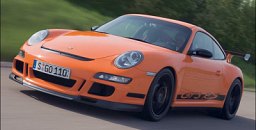 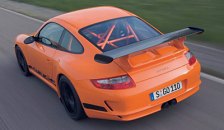
RS, or Rennsport, is the
911
closest to a racing car. For 20 percent higher price than the standard
GT3, it gives you a roll cage, a 34mm wider rear track and a reduction
of 20 kilograms. The latter is achieved by ditching the rear seats and
sound deadening materials, by using Perspex rear window, carbon fiber
bucket seats and carbon fiber rear spoiler. The rear spoiler is also
larger than the GT3's in order to generate superior downforce. Drag
coefficient increases from 0.29 to 0.30.
The
3.6-liter boxer engine remains unchanged from the GT3 – at 415
horsepower, it is already highly tuned. However, it mates with a
lighter single-mass flywheel to sharpen throttle response. This makes
the world's best six-cylinder engine even more tempting. As for
suspensions, the two-stage adaptive dampers have been stiffened but
ride height and tires remain unchanged. On public roads, the ride is a
little too stiff for a road-going machine, although it is already more
forgiving than the last generation. The standard GT3 is a better road
car, but the RS is designed for tracks. Walter Rohrl found it take 4
seconds less to lap Nurburgring, mainly due to the superior rear-end
stability and downforce.
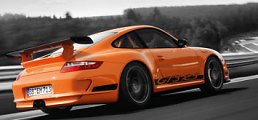 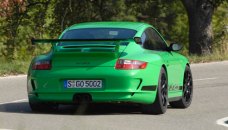 |
Verdict:      |
Published
on 9
Jun 2009
|
All rights reserved.
|
|
911 GT3 3.8
|
|
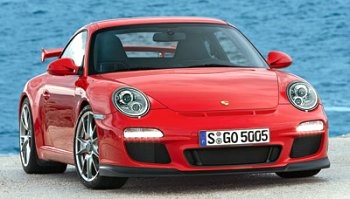
|
Considering the 2006 version is still
a great drive today, we wonder how Porsche can improve on it...
|
Since
911 GT3 was first introduced in 1999, it has been one of our
favourites. In the past 10 years, very few sports cars could match its
raw driving thrills, and fewer again could offer the same kind of
everyday usability at the same time. Originally conceived as a limited
production for homologation, the GT3 is now made in greater numbers to
satisfy demand – the last generation sold 5200 units between 2006 and
2008 – and its continuous evolution makes limited production
meaningless. This year, the GT3 entered the fourth generation, or
second generation in 997-era. Considering the 2006 version is still a
great drive today, we wonder how Porsche can improve on it.
The new GT3 is again a small evolution of the old car, but it has
altered nearly all areas slightly to find extra performance in
Porsche’s fashion. This starts from the GT1-derived boxer engine.
Previously displacing 3600cc, it has been bored out from 100mm to
102.7mm, taking capacity to 3797cc. So welcome back the 3.8 designation
! (remember the last air-cooled RS 3.8 ?) Apart from extra capacity,
the engine gets Variocam at both intake and exhaust valves to improve
breathing efficiency and make EU5 emission standards easier to comply.
Direct fuel injection, however, is not available to the race conceived
engine yet. Maybe next time. Anyway, the big-bore engine is more revvy
than ever, as its redline inches up from 8400 to 8500 rpm. Its maximum
output is raised by 20hp to 435hp, delivered at the same 7600 rpm. Max
torque is increased by 18 lb-ft to 317 lb-ft at 6250 rpm.
Although 20 extra horsepower at the top end hardly sounds spectacular,
you can’t deny that 115 horsepower per liter is very impressive, as are
its performance claims of 0-60 mph in 4.0 seconds (0.2 quicker than
before), or 0-100 mph in 8.2 seconds (0.5 quicker). Once it is rolling,
the GT3 will beat 911 Turbo and Nissan GT-R at any speed, thanks to a
superior power-to-weight ratio which is made possible by its 1395kg
kerb weight.
Yes, the new GT3 is not a single kilogram heavier than the last
version. Its 3.8 engine should have meant more weight, but in fact it
is 1kg lighter than the 3.6 engine, thanks to the weight trimmed from
its oil pumps, twin-mass flywheel and air-con compressor. The rest of
the car also underwent diets. Look at those lightweight forged aluminum
wheels, they employ a single bolt to save weight like race cars. And
for your record, the GT3 rejected PDK gearbox because that would have
added 30 kg over its conventional 6-speed manual.
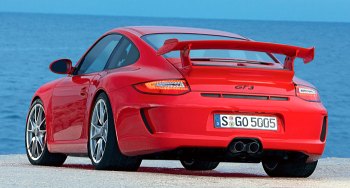
|
This could be a bad news to the
development team of the next generation GT3...
|
The
least improvement over the 2006
version is probably top speed, which inches up from 193 to 194 mph.
This is because the new GT3 has its Cx increased from 0.29 to 0.32.
Porsche admitted its aerodynamic development refocused from drag to
downforce, as the latter could improve its stability at speed hence
on-track performance. The new GT3 has a deeper lip spoiler and 3
additional air outlets above the nose to increase front end downforce.
At the back, it employs a wider rear wing angled at 7.8 degree. As a
result, 100 kg of net downforce is realized at 186 mph, versus the old
car’s 30 kg. Moreover, this downforce is distributed 40:60 front to
rear to match its static weight distribution, so handling balance
remains unchanged at any speed.
The increased downforce called for a rethink in suspension tuning -
stiffer front springs, narrower front anti-roll bar, thicker rear
anti-roll bar and retuned PASM adaptive damping. The ultra-low lip
spoiler called for an automatic jack up facility to increase front
ground clearance for 30mm so to avoid damages by rough surfaces.
However, the most interesting new feature is adaptive engine mount,
which uses magnetorheological fluid to alter the stiffness of engine
mounts (like magnetorheological dampers). In normal driving, the engine
mounts are set soft to reduce NVH. When computer sense the car is being
driven hard, it automatically stiffens the engine mounts to limit
weight transfer, hence improving body control. It goes without saying
that the tail-heavy 911 needs this feature more than anyone else.
The new GT3 continues to equip conventional brakes as standard and PCCB
ceramic brakes as option. Unless you regularly take the car to track
days, the steel brakes will be more than capable to do the job,
especially as they have been upgraded - the front discs now measure
380mm instead of 350mm, and all four discs now employ aluminum carriers
to cut unsprung weight.
Having gone through all the technical changes, we come back to the most
important question: How much is it better than the 2006 version ?
If you ask Walter Rohrl, he will give you a number: 5 sec. The new GT3 takes 7 min 40
sec to lap Nurburgring Nordschleife in the hands of Rohrl, compare with
7 min 45 sec of the old car - although I remember it was claimed to be
7 min 42 sec back then.
In real world, the new GT3 neither disappoints nor surprises, it just
progressed as we expected. It isn't hugely faster than the old car, but
it improves a little bit in every department. The marvelous motor still
revs linearly towards sky-high rpm while producing the most addictive
sound, but its extra shove is noticeable from mid-range. The handling
of GT3 is still the purist this side of Lotus Elise, being responsive,
honest and engaging, but now you can feel the extra stability at speed.
The changes in suspensions and unsprung weight might have an effect in
its steering, as the latter becomes more accurate and less nervous. The
safe-oriented initial understeer built into the previous GT3 has been
markedly reduced, so the nose can be steered more incisively. All these
improvements might not be revolutionary, but they can be easily felt in
the first mile of drive.
The other goodies remain: the Michelin Pilot Sport PS2 rubbers produce
endless grip. The brakes are first rate, steel or ceramic. The ride
quality is surprisingly forgiving for a car with such racing intention.
The cockpit has enough creature comfort for everyday use. Brilliantly,
the GT3 keeps all the best points and improved on the weak ones. There
seem to be not a single drawback.
This could be a bad news to the development team of the next generation
GT3. For sure, they will need to work extra hard to find space for
improvement again. |
Verdict:      |
| Published
on 15
Feb
2010 |
All rights reserved.
|
|
911 GT3 RS 3.8
|
|
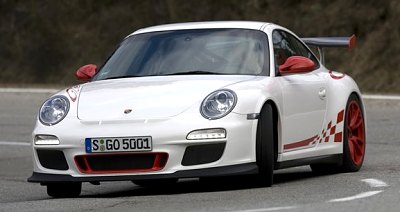
|
RS version sits right on the border
between road cars and race cars...
|
911 GT3
RS has always been the hardcore choice among hardcore drivers. While
the standard GT3 is perhaps the extremest road car next to race cars,
the RS version sits right on the border between road cars and race
cars. On the one hand it is legal and livable to use on public roads,
on the other hand it can be driven straight into racing circuits,
fighting for trophies in weekend racing days. This can be easily seen
from its race-ready looks - extended lip spoiler and sills, wheel arch
extensions (contributing 26mm and 44mm to front and rear tracks
respectively) and in particular the huge carbon-fiber rear wing mounted
highly on aluminum brackets. At 300 km/h (186 mph), the GT3 RS
generates 170 kg of downforce, 70 percent more than the standard GT3.
Even more obvious for its racing intention is the roll cage
built into its cockpit. The added weight is compensated by deleting
creature comforts of any kind - air-conditioning, sound insulation and
audio system have no place in this car. The rear screen is converted to
lightweight plexiglass. Overall, the RS is lighter than the standard
car by 25 kilograms. More can be saved if not it employed wider tires
(245 front and 325mm rear) to improve roadholding and bigger brakes
(380mm front and 350mm rear) to enhance stopping power. Ceramic discs
is still a priced - and pricey - option, as is a 10 kg-saving
Lithium-ion starter battery. Part-time racing is never a cheap hobby.
Unlike the previous incarnations, this GT3 RS also brings more
horsepower than the standard GT3. By raising compression ratio from
12.0 to 12.2:1 and improving engine breathing (by means of new air
filter, reshaped intake manifolds, additional intakes to increase ram
air effect and using a freer flowing titanium exhaust), the 3.8-liter
engine becomes even more hungry for rev. It releases another 15
horsepower at 7900 rpm. The peak of its torque curve also shifts 500
rpm higher to 6750 rpm.
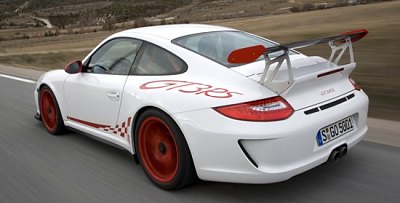
|
For pure driving excitement, nothing
else in the current lineup of Porsche can match...
|
The
transmission of RS is still that good old 6-speed manual gearbox,
without magical semi-automatic or twin-clutch mechanism. However,
shorter ratios in the first 5 gears do sharpen acceleration response.
The RS accelerates from 0-60 mph in 3.9 seconds, or a scant 0.1 less
than the standard car. Nevertheless, the big downforce compromises its
top speed a little, dropping that by 1 mph to 193 mph.
On the road, the RS does not catch you attention by its extra
performance, which is too thin to tell from the cockpit, but the
thundering noise of its engine. That composite rear window and lack of
sound insulation allows the full volume of engine noise to fill the
cockpit. Aurally, this is the rawest and most thrilling Porsche road
car. Apart from noise, the boxer engine also feels a little sharper in
throttle response, thanks to its lighter single-mass flywheel. There is
more vibration at idle, but once the engine revs into the mid-6 grands,
it starts getting more enthusiastic than the standard GT3 engine,
tempting you to access the last 2000 rpm.
You might think the ride of RS should be race-car hard. Surprisingly,
it is actually pretty livable as a road car. The PASM adaptive damping
keeps the firmer suspension in check, so its ride quality is just
marginally worse than the standard GT3. Meanwhile, the handling is
stronger again, no matter roadholding, braking or stability. The
steering is even more feelsome than the GT3's, which means this is one
of the best steerings in any cars you can buy. The wider tracks and
improved front-end grip bring more neutrality into the chassis balance,
so you can go faster yet feeling more confident in corners. Its limit
is so high that virtually impossible to reach on public roads.
For pure driving excitement, nothing else in the current lineup of
Porsche can match GT3 RS. However, to enjoy this you have to make sure
you can live with its deaf-making noise, the lack of air-con and audio
and, finally, a price premium of £20,000. Undoubtedly, the
standard GT3
is more sensible for road use, so you need to be really hardcore to
choose RS instead. |
Verdict:      |
| Published
on 9
Jun
2011 |
All rights reserved.
|
|
911 GT3 RS 4.0
|
|

The engine employed by
Porsche 911 GT3 is usually referred to "Mezger", a name gifted by its
creator, Porsche's long-time motorsport department head Hans Mezger.
Naturally, the Mezger engine was developed for motor racing in the
first hand. Compare to the flat-six engines on regular 911s, it has a
stronger crankcase and crankshaft so that it can take on higher
stresses expected in motor racing. Dry-sump lubrication also differs it
from the road-going engines, allowing it to work reliably at high
g-force. The Mezger engine was first introduced to road use – if you
count that as a road car – in 1997 in the form of 911 GT1. That was a
twin-turbo 3.2-liter unit producing 544 horsepower. Two years later,
the engine was derived into a 3.6-liter naturally aspirated unit with
360 horsepower. It gave birth to the first generation GT3.
After 14 years, the Mezger engine is finally coming to its last
evolution. As the eye-catching graphics on the latest GT3 RS shows, the
headline is 4.0-liter capacity. It will be the largest and ultimate
version of the Mezger engine because Porsche has pretty much squeezed
out its potential. In fact, in the previous 3.8-liter version its bore
size was already maxed out at 102.7 mm, so the extra capacity has to
come from a 4 mm longer stroke, which isn't ideal for a performance
engine. We have been told that the next generation GT3 – based on 991
platform – will switch to a new motor. As a result, the GT3 RS 4.0
shown here will be the farewell edition of the legendary engine. If you
haven't ordered one yet, sorry, it's too late. Porsche is going to
build only 600 units of this car, and all of them have been sold out.

Externally, the RS 4.0 does not differ much from RS 3.8. Aside from the
"RS 4.0" graphics, the easiest way to identify the new car is the
racing-style winglets located at the front overhang. They have not been
used on any Porsche road cars before. The winglets generate extra
downforce at the front axle to balance the increased downforce
generated by the huge rear wing, which is now set at larger angle.
Overall, the car produces 190 kg of downforce at top speed. On the down
side, aerodynamic drag coefficient increases slightly from 0.33 to
0.34, which explains why its top speed remains unchanged at 193 mph.
The chassis also gets slight improvements. The suspension control arms
are now rigidly connected to the chassis via rose joints instead of
rubber bushings, something transferred from GT2 RS. This should improve
its handling precision. Also like GT2 RS, it employs more lightweight
features, such as carbon-fiber front bonnet, front fenders and bucket
seats. Lightweight Lithium battery is made standard, as are lightweight
springs and aluminum dampers. As a result, the car's kerb weight has
been reduced by 10 kg, despite of the larger engine.
However, by far the most significant modification is the 4-liter
engine. Now 102.7mm bore and 80.4mm stroke results in 3996 cc.
Normally, the increase of stroke could have had adverse effect on
revvability and specific output, but Porsche counteracts with a higher
(12.6:1 vs 12.2:1) compression ratio, a modified intake manifold with
shorter runners, lower restriction air filters and freer flowing
catalytic converters. The resultant smoother breathing frees up its top
end power delivery, boosting output by 50 ponies to a full 500
horsepower. Moreover, the peak power is released at 8250 rpm, actually
350 rpm higher than before. Any worry about a lazier character is
washed away. The last incarnation of Mezger engine can rev to 8500 rpm
before fuel cut-out, the same as the 3.8-liter motor.
As expected, the longer stroke improves torque output. Not only peak
torque is lifted by 22 lbft to 339 lbft, but its occurrence is a full
1000 rpm earlier than before.
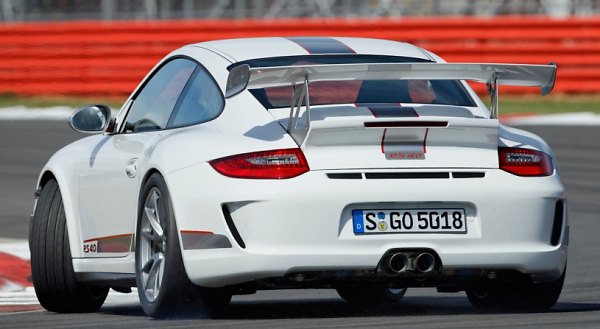
On the road, it is the higher and flatter torque curve that makes the
difference. This engine is much more flexible low down, more so than
the increased peak torque can tell. It finally provides a mid-range
punch to match the widely spaced ratios of the 6-speed manual gearbox.
As a result, you can always corner at a gear higher than in the 3.8 RS.
Less work on the gearshift allows you to concentrate on the helm and
brakes, so it is faster yet more enjoyable to exploit. On the other
hand, the superb noise and linearity of the old motor are unaltered.
Benefited by the rose-joints suspensions and increased downforce, the
handling is even sharper than before. It responds to your steering
input more quickly and precisely, which is no small achievement
considering how good the old car was. Meanwhile, the ride remains
composed on most roads, thanks to the carried-over PASM adaptive
damping and adaptive engine mount.
On the ground of pure driving fun, the RS 4.0 is the best of the best
breed. It's not the fastest in the world, but it is definitely the most
exciting sports car to drive. Its response, its noise, its perfectly
weighted controls, its communication, its grip, its poise, its fluency,
its brakes and, most important of all, its character, all engage the
soul of keen drivers.
The Mezger engine – as well
as the 997 generation – are set
to retire after this car. While it is a sad news, we must say nothing
could be better than bowing out high in this way. Long live Mezger !
Long live RS 4.0 !
|
Verdict:      |
|